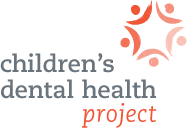Early Childhood Caries (ECC)
Early Childhood Caries (ECC), the bacteria that causes tooth decay, is a significant health problem for children. In fact, nearly half of all 5-year-olds have experienced tooth decay. Those “baby teeth” are important — a healthy mouth helps children eat, speak, learn and play without pain. Because ECC is a chronic disease, it can also compromise the health of emerging permanent teeth.
The good news is that nearly all tooth decay can be prevented. Early brushing with fluoride toothpaste is important (see the latest tooth brushing guidelines), and so is exposure to fluoridated tap water. A child’s diet shapes ECC risk, especially exposure to sugars. Many beverages contain sugar, including formula and fruit juices. In mouths young and old, bacteria feed on sugar and emit acids that slowly damage enamel — the hard surface that protects teeth.
The Children’s Dental Health Project (CDHP) works in several ways — and with many partners — to advance cost-effective, evidence-based strategies for reducing ECC. In New York State, for example, we are assisting community stakeholders in setting their own ECC prevention priorities. In Colorado, we introduced a simulation model for ECC prevention that projects the potential of different approaches for reducing the prevalence of ECC.
ADDITIONAL RESOURCES:
- Strategies for Sustaining and Enhancing Prevention of Childhood Tooth Decay during Challenging Times
This second issue of TrendNotes, a series report designed to highlight emerging trends in children's oral health, focuses on strategies for sustaining and expanding efforts aimed at the prevention of ECC during challenging fiscal times for states.
- Opportunities for Preventing Childhood Dental Caries through Implementation of Health Care Reform
This third issue of TrendNotes provides an overview of the oral health provisions contained in the Patient Protection and Affordable Care Act (ACA). It also discusses how the ACA builds on provisions included in the reauthorization of the Children’s Health Insurance Program to build and strengthen a comprehensive system of oral health for children.
- Beyond the dmft: The Human and Economic Cost of Early Childhood Caries
This report, published in JADA: The Journal of the American Dental Association, goes beyond the dmft (decayed-missing-filled teeth) index used to assess tooth decay and describes morbidity and mortality associated with ECC and its treatment.
- A Simulation Model for Preventing ECC
CDHP worked with Colorado stakeholders to conduct a simulation model that estimated the impact that six different types of oral health strategies would be likely to have on the oral health of young children. A 2012 journal article shared these findings.
- ASTDD Policy Statement on ECC
Our colleagues at the Association of State & Territorial Dental Directors (ASTDD) issued this ECC prevention policy statement in 2012. ASTDD also recommends that prevention efforts “should include educating the mother and other primary caregivers about the transmission of bacteria that causes tooth decay and assessing a young child’s risk for decay.”
